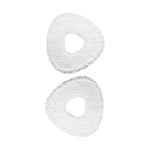Robot vacuums with floor type detection can clean more intelligently by recognizing surfaces like carpet, tile, or wood, then adjusting suction or mopping accordingly. This capability ensures better performance, longer battery life, and protection for delicate floors.
In this guide, we explain what floor type detection means and how advanced technologies—such as SLAM, LiDAR, and pressure sensors—help robot vacuums detect and adapt to different floor types. You’ll also learn how this feature improves cleaning efficiency, from suction control to navigation.
We also answer whether robot vacuums can detect rugs and thin mats, and help you decide if investing in a model with floor detection is right for your home.
What Is Floor Type Detection in Robot Vacuums?
Floor type detection enables robot vacuums to recognize different surfaces in your home, such as carpets, tiles, or wood. This feature allows the vacuum to adjust its cleaning method accordingly. In this section, we explain what floor type detection means and why it plays a key role in improving cleaning performance and protecting your floors.
Why Detecting Different Floor Types Is Crucial for Robot Vacuums?
Understanding the different types of floors in your home is essential for robot vacuums. This capability allows the vacuum to adjust its cleaning method based on the surface it’s working on. For example, a vacuum can increase suction power on carpets to pull out dirt deeply embedded in the fibers and decrease power on hardwood floors to avoid scratches and conserve battery life. Without this capability, your vacuum might not clean efficiently and could even damage your floors.
Benefits of Floor Type Detection
- Optimized Cleaning: When a robot vacuum knows the type of floor it’s cleaning, it can adjust its cleaning technique accordingly. This means better dirt and dust removal, whether it’s on a thick carpet or a smooth tile floor. The result is a more thorough cleaning throughout your home.
- Battery Efficiency: Different floor types require different levels of effort to clean. Carpets, for example, need more suction power, which can drain the battery faster. By detecting floor types and adjusting the cleaning power, robot vacuums can use their battery more efficiently, leading to longer cleaning sessions without needing to recharge.
- Protection of Floors: Some floors, like hardwood or delicate tiles, can be easily scratched or damaged by too much suction or the wrong brush type. Floor-type detection helps prevent this by allowing the vacuum to adjust its settings, ensuring gentle yet effective cleaning on sensitive surfaces.
These benefits show why it’s crucial for robot vacuums to detect and adapt to different floor types. Not only does it lead to better cleaning results, but it also protects your investment in both your floors and your vacuum.
How Do Robot Vacuums Detect Different Floor Types?
Robot vacuums detect and adapt to different floor types by using a variety of advanced technologies. These technologies include sensor mapping, camera mapping, gyroscope navigation, SLAM, LiDAR, and pressure sensors. Each of these technologies plays a unique role in helping the vacuum navigate and clean your home efficiently.
SLAM (Simultaneous Localization and Mapping)
SLAM is a sophisticated algorithm that allows the vacuum to create a map of its environment while simultaneously determining its position within that map. This technology uses data from various sensors, including cameras and LiDAR, to build real-time maps of your home. SLAM enables the vacuum to navigate complex environments, avoid obstacles, and adapt to different floor types with high precision.
Lidar (Light Detection and Ranging)
LiDAR technology uses laser light to measure distances to objects in the surrounding environment. It emits laser beams that bounce off surfaces and return to the sensor, providing accurate distance measurements. This data helps the vacuum create detailed 3D maps of your home, allowing it to navigate efficiently and detect different floor types. LiDAR is particularly effective in low-light conditions and provides precise navigation.
Camera mapping
Camera mapping uses built-in cameras to capture images of the floor and surrounding environment. This visual data helps the vacuum distinguish between different surfaces, such as carpet, tile, or hardwood. The camera can also assist in creating detailed maps of your home, which the vacuum uses to plan efficient cleaning paths. Camera mapping enhances the vacuum's ability to avoid obstacles and ensure thorough cleaning of all areas.
Sensor mapping
Sensor mapping is one of the earliest and most basic navigation methods used by robot vacuums. It employs a variety of sensors to determine the vacuum’s position on the floor and identify different surface types. Common sensors include cliff sensors to avoid stairs, wall sensors for edge cleaning, and bump sensors to detect obstacles. These sensors work together to help the vacuum navigate around your home and adjust its cleaning method based on the floor type it detects.
Pressure Sensors
Pressure sensors measure the vacuum’s pressure on the floor, helping it identify different surface types based on resistance. For example, moving from a carpet to a hard floor changes the amount of pressure the vacuum experiences. By detecting these changes, the vacuum can adjust its cleaning settings, such as suction power, to optimize performance for each floor type. Pressure sensors contribute to efficient cleaning and protection of delicate surfaces.
Gyroscope navigation
Gyroscope navigation involves using gyroscopes to measure the orientation and movement of the vacuum. This technology helps the vacuum understand its position and direction as it moves across different floor types. By combining data from the gyroscopes with other sensors, the vacuum can navigate more accurately and adjust its cleaning settings based on the floor type it encounters.

Why Floor Type Detection Improves Cleaning Efficiency
Floor detection is not just smart technology. It directly impacts how well a robot vacuum cleans your home. This section explains how it improves suction control, mopping accuracy, and navigation efficiency.
Adjusting Suction Power
One of the primary benefits of floor type detection is the ability to adjust suction power based on the surface being cleaned. For instance, carpets typically require stronger suction to remove embedded dirt and dust, while hard floors need less suction to avoid damage. By detecting the floor type, the vacuum can automatically increase suction on carpets for a deeper clean and reduce it on hard floors to save battery life and prevent scratches. This dynamic adjustment ensures that each surface in your home is cleaned effectively without unnecessary wear and tear on the floors or the vacuum.
Mopping Functionality
Some advanced robot vacuums come with mopping capabilities in addition to vacuuming. Floor-type detection plays a crucial role in enhancing this functionality. When the vacuum moves from a carpeted area to a hard floor, it can automatically switch to mopping mode if the feature is enabled. This ensures that hard surfaces like tiles and wood are mopped for a thorough clean, while carpets are only vacuumed to avoid wetting. Additionally, floor type detection allows the vacuum to adjust the amount of water dispensed for mopping based on the floor material, ensuring optimal cleaning without causing damage.
Path Planning and Navigation
Effective path planning and navigation are essential for efficient cleaning, and floor type detection significantly enhances these aspects. By recognizing different floor types, the robot vacuum can plan its route more intelligently. For example, it can prioritize high-traffic areas or adjust its path to avoid obstacles unique to certain floor types. This capability reduces cleaning time and ensures comprehensive coverage of the entire cleaning area. Advanced navigation systems, combined with floor type detection, allow the vacuum to avoid repetitive cleaning of the same spots and navigate seamlessly between different rooms and surfaces, providing a hassle-free cleaning experience.

Can Robot Vacuums Detect Area Rugs or Thin Mats?
Many robot vacuums can detect area rugs and thin mats by using sensors that recognize changes in surface height and texture. When transitioning from hard floors to rugs, these devices often increase suction automatically to remove embedded debris. Advanced models may also lift the mop or adjust cleaning modes to avoid wetting soft surfaces. This helps protect delicate materials and ensures effective cleaning across different floor types.
Which sensors help robot vacuums detect floor types?
Floor-cleaning robots use various sensors, including cliff sensors, wall sensors, bump sensors, optical encoders, pressure sensors, cameras, LiDAR, and gyroscopes. These sensors help the robot detect edges, navigate around obstacles, and identify different floor types.
How do robot vacuums map and plan cleaning paths?
Robot vacuums use technologies like sensor mapping, camera mapping, gyroscope navigation, SLAM, and LiDAR. These technologies help the vacuum create maps, detect obstacles, and plan efficient cleaning paths to cover your home thoroughly.
Choose a Robot Vacuum with Floor Type Detection
Floor type detection is a key feature that enhances how robot vacuums clean your home. By recognizing different surfaces, these devices can adjust suction levels, mopping actions, and navigation paths to deliver more efficient and safer cleaning. Technologies such as SLAM, LiDAR, and pressure sensors enable smooth operation across various floor types, helping protect delicate materials and improve battery use.
For homeowners in Australia, where multiple floor types often appear in the same living space, this feature ensures consistent results without manual intervention. If you want better cleaning across tiles, carpet, and wood, consider investing in a robot vacuum with advanced floor-type detection. Visit Narwal AU to explore options designed for your home.




















































